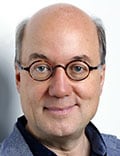Treatment with a novel, minimally invasive brain pacemaker cut seizure frequency by at least 50% in patients with drug-resistant focal epilepsy, new research shows.
The meta-analysis examined data from two first-in-human clinical trials of focal cortex stimulation (FCS) with an epicranial neuromodulation system called Epicranial Application of Stimulation Electrodes for Epilepsy (EASEE).
The therapy uses a specially designed electrode placed outside the cranium in the region of the brain where a patient’s seizures begin.
After 6 months of treatment, 53% of patients with uncontrolled seizures even after trials of up to seven anti-seizure medications (ASMs) reported at least a 50% reduction in seizure frequency.

Dr Andreas Schulze-Bonhage
The device works as a pacemaker by preventing abnormal brain synchronization, which helps maintain normal brain rhythms, lead investigator Andreas Schulze-Bonhage, MD, professor of neurology and clinical neurophysiology and head of the epilepsy center at the University Medical Center, University of Freiburg, Germany, told Medscape Medical News.
“A new, minimally invasive neurostimulation method has shown efficacy in pharmacoresistant epilepsy, which offers a new chance for a considerable group of patients with focal epilepsy who presently have limited treatment success,” he said.
The findings were published online April 3 in JAMA Neurology.
First-in-Human Trials
For the study, investigators analyzed pooled data from the EASEE II and PIMIDES I clinical trials, first-in-human trials of the system that were conducted at seven European epilepsy centers. The nonrandomized, open-label studies began in January 2019 and January 2020, respectively, and ended in July 2021.
The trials included 33 patients who experienced at least three focal-onset seizures per month that were uncontrolled by at least two ASMs.
Patients undergo general anesthesia for implantation of the EASEE system. Electrodes are placed outside the cranium above a patient’s epileptic focus region and are connected to a pulse generator implanted subcutaneously in the pectoral region.
Treatment began 1 month after implantation with intermittent bursts of 100-Hz high-frequency stimulation (HFS) every 2 minutes combined with 20 minutes of continuous cathodal direct current–like stimulation (DLS) per day.
In total, 32 individuals underwent treatment at least until the 8-month post-implant follow-up visit.
The primary endpoint, a treatment response defined as a 50% reduction in seizure frequency, was achieved by 17 of the 32 participants (53.1%) at 6 months.
The therapy continued to show greater efficacy as time went along, and all 6 of the early responders during the first 3 months of FCS treatment remained responders in the subsequent 3 months.
During the sixth month of treatment, 4 of the 32 patients (12.5%) had no seizures at all.
“Certainly, one may not conclude that seizure-freedom during the sixth month of treatment also predicts seizure freedom in the long-term,” Schulze-Bonhage said. “However, for most stimulation approaches a progressive increase in efficacy has been reported over prolonged periods of stimulation.”
There were no serious adverse events reported, which Schulze-Bonhage said is “different from devices implanted intracranially, in which intracerebral bleeding occurs at a rate of about 5%.”
Additional studies are under way to determine whether the efficacy reported in this study was driven more by HFS or DLS stimulation, information that would help fine-tune the device. Investigators also want to identify factors that contributed to some patients’ higher response rates compared with others.
Plans are also underway for a US randomized trial of the therapy, although the timing of that trial has not yet been set.
More Data Needed
Commenting on the findings for Medscape Medical News, Jacqueline A. French, MD, professor of neurology at New York University Grossman School of Medicine, New York City, called the findings “interesting” but noted that more work is needed.
“This device represents a potentially less invasive new stimulation that could aid in the treatment of difficult to control epilepsy, but we need to wait for additional data to determine its place in the armamentarium,” French said.
Focal cortex stimulation is less invasive and does not cause hoarseness, two advantages over other stimulation devices, French said. However, the study’s open-label design and short follow-up are a concern.
“The overall results are encouraging, but it appears as if there was a substantial drop in the sixth month,” said French, who is also chief medical/innovation officer of the Epilepsy Foundation and was not a part of this study. “More follow-up would be needed to see if the improvement persisted, or even increased over time.”
The study was funded by German Federal Ministry of Education and Research and sponsored by PRECISIS GmbH. Schulze-Bonhage has received grants from the German Ministry of Science and Education Project PIMIDES, Precisis Projects EASEE and PIMIDES, Medtronic MORE-registry, and UNEEG Medical honoraria or consulting fees from Angelini Pharma, Bial, Desitin, Eisai, GW Pharmaceuticals, and UCB Pharma outside the submitted work. French reports no relevant financial relationships.
JAMA Neuro. Published online April 3, 2023. Full text
Kelli Whitlock Burton is a reporter for Medscape Medical News covering neurology and psychiatry.
For more Medscape Neurology news, join us on Facebook and Twitter
Source: Read Full Article
